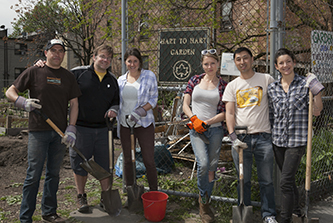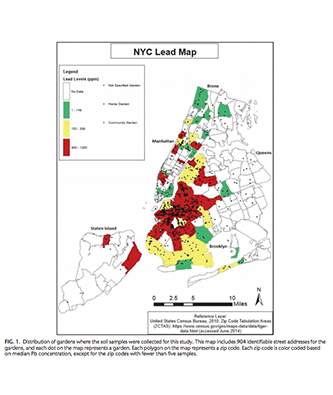Urban Soils Institute at Brooklyn College Raises Awareness About Lead in NYC Soil
June 27, 2016

From left to right: Andres Saldarriaga '12, Jonathan Russell-Anelli, Anna Minsky, Tatiana Morin, Zhongqi (Joshua) Cheng, and Sara Perl.
At the Hart to Hart Community Garden in Brooklyn’s Bedford-Stuyvesant neighborhood, a group of scientists dressed in plaid shirts, t-shirts, and work boots collectively heave-ho a patch of soil they are mixing. There’s a gentle breeze passing through the garden, and a not so distant construction buzz as they homogenize the underlying soil with some fresh dirt and snatch out worms to bring back to the lab.
"The beauty of what we do," says Tatiana Morin, director of the NYC Urban Soils Institute, which is housed at Brooklyn College, "is that it’s not pretty."
Their digging feeds into the mission of the institute, the first of its kind in the country and one that many soil scientists and environmentalists hope can be replicated in other cities.
The environmental scholars working the garden today include two professors—Zhongqi (Joshua) Cheng, the chair and an associate professor in Brooklyn College’s Department of Earth and Environmental Sciences, and Jonathan Russell-Anelli, a senior lecturer and senior extension associate at Cornell University’s College of Agriculture and Life Sciences. There’s also Morin, who is completing her Master of Science in earth and environmental sciences. Sara Perl will be entering the CUNY Graduate Center’s Earth and Environmental Sciences Ph.D. program in the fall. Andres Saldarriaga '12, is a student in the master’s program and also works at an environmental conservation firm. Anna Minsky, a research assistant and a former student of Perl’s at the New York Botanical Garden, joins the group. She is simply looking to get her hands dirty with some soil scholarship.
The scientists from the soils institute have been working here for three months, sending the graduate students to work with the gardeners every week. The institute helps to test and remediate the gardeners’ soil, and in return gets a lab-worthy plot from which they can check the environmental deposition effects of heavy metals on soil and plants.
Through their work, the researchers also build important ties to this ethnically and economically diverse community. When a man yells from his window in the adjacent apartment building, "Hey, you guys are standing on my squash," Perl quickly smooths things over. "Sorry Anthony," she says. "We will be extra careful to just step on the weeds." He relents and then promises to come down later to say hi. The soil scientists decide to build him a border.
The institute opened a year ago and is partnered with a number of government agencies including the United States Department of Agriculture, the New York City Soil and Water Conservation District, the NYC Department of Parks & Recreation, the NYC Department of Environmental Protection, and the NYC Mayor’s Office of Environmental Remediation, among others. It bolsters collaborations with soil scientists across the region and conducts soil testing and other technical services for city agencies. It also serves as a data depository, offers education and outreach to the community, and conducts research that puts it at the forefront of sustainable resource management and conservation in New York City.
"Most people know about the dangers of lead in our water," says Cheng, who also serves as director of the Environmental Sciences Analytical Center at Brooklyn College. "But many people don’t think about the exposure they get from soils."
The soil in urban areas tends to have particularly high levels of heavy metals, much of it still around from the days when gasoline and paint contained lead—which does not biodegrade but burns off into the air and then deposits in the soil.
Of particular concern to the researchers is the exposure that plants and gardeners get from the roughly 2,000 community gardens in New York City—many of which were created on abandoned lots that had been contaminated. They are also looking at parks, including those frequented by children, who are especially susceptible to the effects of lead poisoning.
A map of lead distribution in New York City that the institute just published has been referenced by scholars and journalists, many of whom are jumping on what has become a hot topic since the contaminated water crisis in Flint, Mich.
"This issue will only become more prominent," says Cheng. "We plan to be at the forefront of it."







